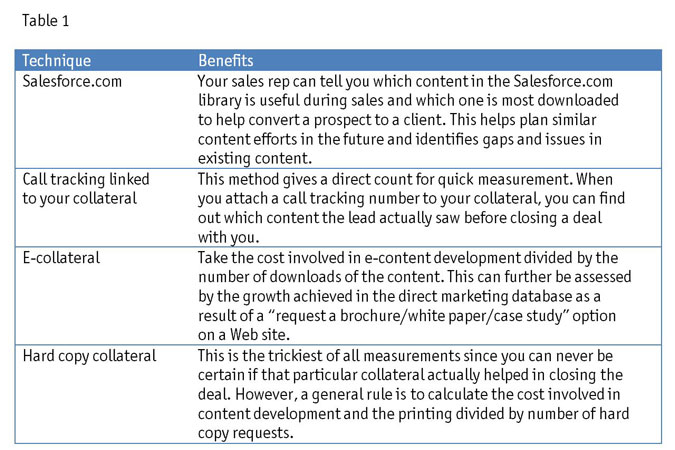Editor's note: V. Kanchana is an independent researcher based in New Delhi. She can be reached at v.kanchana10@gmail.com. This article appeared in the October 28, 2013, edition of Quirk's e-newsletter.
Marketing communications managers in the B2B space face a strategic decision each time they select marketing collateral for generating leads and effective sales conversion. Many people feel that the value of marketing collateral cannot be measured and quantified since it is more of an art than science. However, with the advent of new measuring techniques, B2B companies can quantify the ROI of marketing collateral used in sales development. This article provides an overview of some of the various techniques used to do so.
The objective of any marketing collateral is to convey the intended message to the target audience. The question is, did your collateral do its work? This is more subjective than objective but if you are interacting with your key clients regularly, getting feedback via a quick survey (probably online) or a short qualitative interview with a few top clients shouldn't be too difficult. This can also provide insight into what your customers think and identify their brand touchpoints.
However, this isn't possible on an everyday basis for many small B2B businesses and most aren't looking to spend resources on a survey or a separate feedback interview with their clients. In such situations, gauging your clients' key brand touchpoints and the marketing media that clients prefer can be difficult. But not gathering this feedback can result in a business decision maker investing in the wrong marketing medium and losing the marketing share and sales revenue.
Some measurement techniques can help decipher which marketing collateral actually works best for sales conversion and customer retention. Table 1 provides a look at some of the tools and techniques for measuring the effectiveness of marketing collateral.

Aligning objectives
Marketing communications can directly help in the success of sales, especially in B2B companies, by aligning their marketing, sales and corporate objectives and coming up with collateral that sales personnel are willing to use.
Focusing on the entire sales process and aligning the marketing communications objectives is crucial. For instance, assigning unique call-tracking phone numbers and unique URLs, tags and codes and printing them on the marketing collateral can help you arrive at a quantifiable value for the collateral's audience reach and ensuring sales success. The infographic below (courtesy of Demand Results) illustrates the benefits of call tracking for measuring your collateral's success.

Get easier
With an increasing demand from customers for e-content, the quantification task is going to get easier. Tracking digital content and measuring its effectiveness is much easier than tracking the effectiveness of hard copies in sales conversion. This is surely going to set the stage for further development in measurement techniques for marketing communications in the coming years. Every marketing communications manager should monitor the digital content and devise means to calculate their spend on digital collateral. Tools like Google Analytics and Facebook Insights are a few of the free options for tracking social media content.
As more and more companies switch to digital media options, the market is flooded with new media software companies trying to come up with innovative solutions for monitoring and effective ROI tracking of digital marketing collateral. This will certainly be helpful for the new generation of marketing communications.
